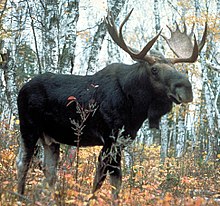Western moose
| Western moose | |
|---|---|
 |
|
| Scientific classification | |
| Kingdom: | Animalia |
| Phylum: | Chordata |
| Class: | Mammalia |
| Order: | Artiodactyla |
| Family: | Cervidae |
| Subfamily: | Capreolinae |
| Genus: | Alces |
| Species: | A. alces |
| Subspecies: | A. a. andersoni |
| Trinomial name | |
|
Alces alces andersoni Peterson, 1952 |
|
The Western moose (Alces alces andersoni) is a subspecies of moose that inhabits boreal forests and mixed deciduous forests in western Canada and a few western sections of the northern United States. It is the second largest North American subspecies of moose, second to the Alaskan moose. Male Western moose are aggressive during mating season (autumn and winter) and may injure or kill with provocation.
The Western moose inhabits British Columbia, eastern Yukon, Northwest Territories, southwestern Nunavut, Alberta, Saskatchewan, Manitoba, western Ontario, the upper peninsula of Michigan, northern Wisconsin, northern Minnesota, and northeastern North Dakota. Parks Canada transferred eighteen western moose from Elk Island National Park to Nova Scotia's Cape Breton Highlands National Park between 1947 and 1949 for population increase. Cape Breton Island's eastern moose are descendants of these western moose.
Western moose eat terrestrial vegetation such as forbs and shoots from willow and birch trees and aquatic plants, including lilies and pondweed. Western moose can consume up to 9,770 calories a day, about 32 kilograms (71 lb). The Western moose, like other species, lacks upper front teeth but instead has eight sharp incisors on its lower jaw. They also have a tough tongue, gums, and lips to help chew woody vegetation.
...
Wikipedia
